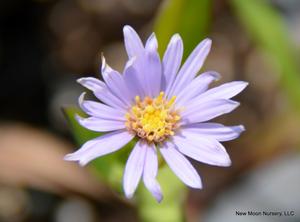New Moon Nurseries

Smooth blue aster is a good perennial for meadows, rain gardens, attracting pollinators, or use as a landscape ornamental. Attracts pollinators.
Aster laevis
Smooth blue aster
Native to North America
FIRST IMPRESSIONS: Along with the goldenrods and native grasses, asters are the quintessential herbaceous fall color plants of North America. This one is a sturdy branching perennial with smooth gray-green leaves. Aster laevis thrives in sun and adapts to most soils. Plants produce billowing panicles of blue-violet flowers in late summer and autumn. The unique flower color draws the eye and beckons to a bevy of butterflies and other pollinators.
HABITAT & HARDINESS: Aster laevis is native to North America from British Columbia to Maine, south to Georgia and west to New Mexico.
Habitats include prairies, savannas, well drained woodlands, dry open woods and disturbed road embankments or thickets.
Plants are hardy from USDA Zones 4-8.
PLANT DESCRIPTION: Aster laevis is upright with arching stems and sparsely branching terminal growth.
The lower leaves of Aster laevis are glaucous. They are thick and smooth and up to 5” long. They lack stalks or petioles and clasp or wrap partially around smooth bluish stems. Upper leaves are tiny and diamond shaped.
Flowers are arranged on branching sprays from late summer through fall. The resilient blooms continue to provide color even after hard frosts.
The flower heads are composed of a ring of blue or lavender petal-like ray flowers surrounding a central cluster of yellow or rose colored disc flowers. The heads are produced in profusion. Beneficial bees, wasps, skippers and butterflies seek the floral nectar.
Plants grow 2-3’ tall with 2-4’ spread.
CULTURAL & MAINTENANCE NEEDS: Aster laevis flourishes in sun or part sun and in medium or dry soils.
Plants tolerate drought and leaves are somewhat unpalatable to deer and rabbits.
To encourage density, plants can be cut back to 6” in late spring. Pruning is usually not necessary because this aster has strong stems that rarely flop.
This perennial is robust and long lived unless it is shaded or crowded out by taller more aggressive companions.
LANDSCAPE USES: This is a good choice for a Wildlife Garden or Meadow. Plants are also used as a Butterfly Nectar Plant, Butterfly Host Plant, Cut Flower or as part of a Grouping or Mass Planting. Aster laevis has Showy Blooms and is appropriate for Cottage Gardens, Deer Resistant Plantings, Water-wise Landscapes, Low Maintenance Plantings, Perennial Borders and Shade Gardens.
COMPANION & UNDERSTUDY PLANTS: Try pairing Aster laevis with Echinacea purpurea, Asclepias tuberosa, Penstemon digitalis, Liatris aspera, Solidago speciosa or Andropogon gerardii.
Aster laevis ‘Bluebird’ would be a suitable substitute.
TRIVIA: Many of the established Latin names of Aster spp. were changed recently due to DNA and genetic research findings. So Aster laevis is now known as Symphyotrichum laeve.
Almost all asters have stems and leaves that are pubescent or rough. Aster laevis is unique in that its stems and leaves are smooth with a glaucous surface. Plants also have distinctive sessile leaves that lack leaf stalks. The leaves clasp the stems and have noticeable ear-lobe appendages at the base.
Plants host caterpillars of the Pearl Crescent Butterflies.
Height:
2-3 ftSpread:
2-4 ftSpacing:
24-36 inUSDA Hardiness Zone:
4-8Bloom Color:
BlueAster laevis Characteristics
Attracts Wildlife
- Butterflies
Attributes
- East-Coast Native
- Drought Tolerant
- Dried Flower
- Cut Flower
- Clay Soil
- Naturalizing
Exposure
- Full Sun to Partial Shade
Flowering Months
- October
- September
- August
Foliage Color
- Green
Growth Rate
- Medium
Juglans nigra Tolerance (Black Walnut)
- Yes
Salt Tolerance
- Medium
Season of Interest (Foliage)
- Fall
- Summer
- Spring
Soil Moisture Preference
- Moist
Interesting Notes:
AKA Symphyotrichum laeve
For more information on this plant, visit the USDA PLANTS Database: http://plants.usda.gov/java/profile?symbol=SYLAC